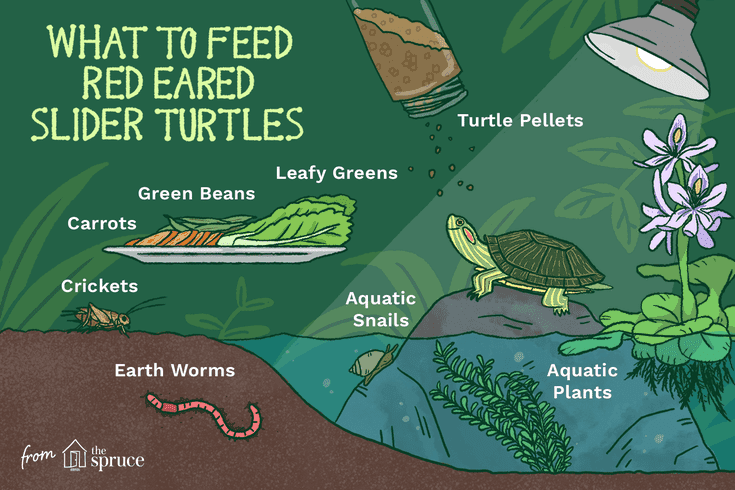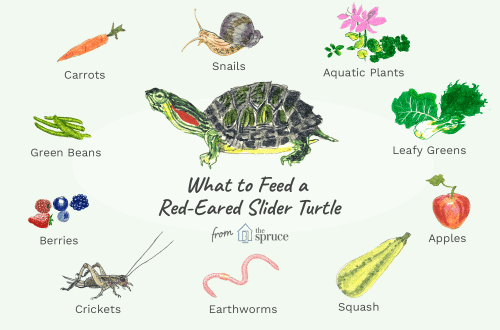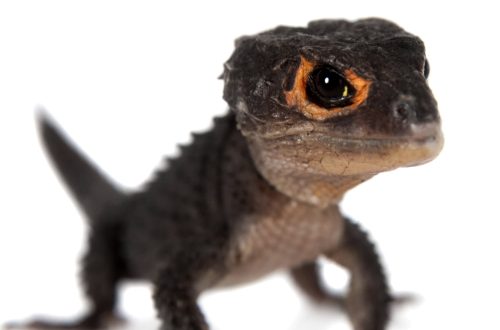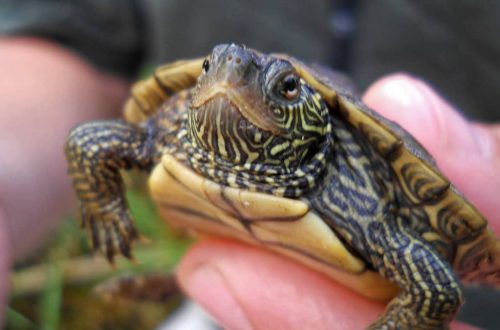
What is the right way to feed turtles?
What to feed predatory, herbivorous and omnivorous turtles? We analyze the basic rules of the diet.
To better understand how to build a turtle’s diet, let’s remember what these animals eat in nature. The diet of turtles shapes the area in which they live.
Many people think that turtles are vegetarians, but they are not. Among turtles there are real predators.
All turtles (even herbivores) need both plant and animal food, and necessarily minerals.
A balanced diet is necessary for normal life and maintaining immunity. When building a diet, be guided by which group the turtles belong to: predators, herbivores or omnivores.
The herbivore group consists of all land turtles. The diet of herbivores should be 95% plant foods and 5% animal.
What is in 95% of food?
Most of the entire diet (about 80%) is fresh greens: flowers, cabbage, herbs and leaves suitable for the breed of your pet. Further (about 15%) are vegetables such as carrots, zucchini, cucumbers. And the last 5% are light fruits: apples and pears.
As an addition to the basic diet of herbivorous turtles, it is useful to give mushrooms, bran, professional dry food for turtles. And also once a month animal food: snails, slugs, fodder insects, etc.
Roughage must be present in the diet of desert tortoises: hard weed grass, hay. Hay can be pre-steamed, especially for young animals.
Different types of turtles are suitable for different foods. If you want to diversify your pet’s diet, take a close look at what foods are good for her and what can harm her.
In no case should herbivorous turtles be given sausages, pates and other products from the table, as well as milk, bread, dog and cat food.
Almost all aquatic turtles belong to this group. The main volume of food of predators is made up of products of animal origin (from 70 to 90%). Everything else is plant food.
The main diet for predatory turtles is low-fat river fish with small bones. It should be given raw, whole (if the fish is small) or in the form of pieces. For small and young turtles, it is better to chop the fish finely. Turtles can also be given a variety of raw seafood.
It should be remembered that feeding only raw fish leads to hypovitaminosis B. The turtle’s diet must be supplemented with foods rich in B-group vitamins. Most often, it is the liver.
Suitable animal food also includes food mammals (hairless mice and rat pups), snails, mollusks, insects: cockroaches, crickets and grasshoppers, worms, bloodworms.
Top-floating aquatic plants, cabbage, vegetables, fruits and special dry food for a specific turtle species are used as a supplement to the main diet.
Like herbivorous turtles, predators should not be fed beef, pork and other meat, either raw or in the form of sausages or pates. Also, turtles are not suitable for light white meat, oily fish, milk, cheese, baked goods and food that is not intended for turtles.
This group includes aquatic, semi-aquatic species and some species of terrestrial turtles. A complete diet of omnivorous turtles is based on animal and vegetable food in equal proportions (50 to 50).
The diet of omnivorous turtles includes food of herbivorous and predatory species, only in a different ratio and with some clarifications.
As animal food for land turtles, rat pups, mice, that is, land animals, are suitable. Whereas aquatic turtles are best fed with seafood and fish. The same goes for plants: aquatic turtles will better absorb aquatic plants, vegetables and fruits are suitable for land turtles.
If you give your turtle the wrong food for a long time, then your pet is likely to have problems with the immune and digestive systems.
Do not forget to enrich the diet with calcium and vitamins, it is enough to give them to the turtle once a week. It is important to give the turtle as much food as it needs, not to overfeed it and not keep it hungry. Turtles have a rather sensitive body. Improper nutrition causes problems with the growth of the body and shell, obesity and the occurrence of various diseases. Don’t feed your turtle unsuitable food. The diet of a predatory turtle should not be based on plant foods, and a herbivore should not be based on animal food.
Follow the recommended food ratios and do not limit your pet’s diet to 1-2 types of food.
Ready-made food for turtles
To keep a turtle healthy for a long time, its diet must be balanced. With a natural type of feeding, it is difficult to achieve an optimal balance. Turtle food needs to be cooked separately and takes time. Therefore, professional feeds are more popular.
Professional feeds do not need to be prepared, and they include a full range of vitamins and minerals in optimal proportions for the turtle. Complete feeds are used as the main food for the turtle, no supplementation is required. There are a huge number of food lines for turtles: for predators, herbivores and omnivores, as well as young and adult reptiles.
Choose a diet designed specifically for your turtle species and follow the feeding instructions on the package.
Approach the diet responsibly, and then your pet will delight you for many years.





